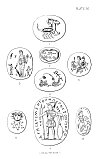
Sacred Texts Gnosticism Index Previous Next
Buy this Book at Amazon.com


The Gnostics and Their Remains, by Charles William King, [1887], at sacred-texts.com

Click to enlarge
Plate M
1. Zodiacal Monster, compounded of Scorpio and Capricornus, carrying a legionary standard. Bearing in mind that the former Sign is under the patronage of Mars, according to Manilius--"Pugnax Mavorti Scorpius haeret"--and the latter a badge of the second Augustan Legion, we may
reasonably suppose this gem to have been engraved for the benefit of some member of that corps. Sard. (New York Museum.)
2. Three lines of the usual Gnostic siglae, in a cartouche formed by a coiled serpent, precisely in the same way that the Brahmins still write the Great Name AUM--a sure evidence of the meaning of these mystic characters. Sard., set in an iron ring, of which only fragments remain.
3. Fortuna, with rudder and horn of plenty, standing. The word Feliciter, in scattered letters, the usual acclamation of the crowd, and the palm-branch prove this gem a present to some favourite auriga. Its purport is the same as that of the monogram so often found enclosed in the field of the Antoniate medal, also accompanied with a palm, which has at last been made out to contain the elements of Palma Feliciter!
4. Masks of Silenus and of Bacchus, combined into the outline of an elephant's head, bearing a caduceus in his trunk. The typical beast of India is an allusion to the Indian origin of the god; and the conceit was a favourite with the Romans, to judge from the number of such compositions that they have bequeathed us. Red jasper. (New York.)
5. Astrological Trine, or figure produced by dividing the circle of the Zodiac into equilateral triangles. Here, Virgo (Astræa) at the apex of a triangle, is borne up by Taurus and Capricorn. This was the horoscope of Pescennius Niger, who placed it on the reverse of a coin, on account of its appropriateness to his surname of Justus, of which virtue Astræa was the emblem.
6. The Gorgon's Head: the type explains itself by the legend, "I protect Rhoromandares"--some Greco-Persian, to judge from his Oriental name. The younger Lucian tells us in his 'Philopatries' that the Gorgon was placed upon the shields of the Heroes as being "a thing that wards off all dangers." Red jasper. (New York.)
7. Mars, grounding arms, in the costume of a soldier of the times of Constantine. The legend declares the virtue of the sigil: "Mars hath cut off the disease of the liver." But a most interesting point in the amulet has been discovered by Prof. Stephens, viz., that the four characters behind the head of Mars are the Runes for ABLE, Help. Under Constantine and his sons, the Franks (as Ammian observes) were paramount in the army. It is easy to conceive how some officer of that nation has thought to augment the great virtue of this important talisman by the addition of one of his national spells. Engraved in a slight manner, upon hæmatite.
8. Naked Warrior, upon a prancing steed, brandishing a mace, that specially Oriental weapon; legend, "The Seal of God." Curious for the material--a turquoise; to the present day the Persians firmly believe in the protective virtue of this gem, to which they give the name of Phiruz--"The Victor."